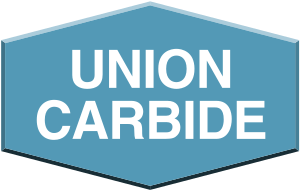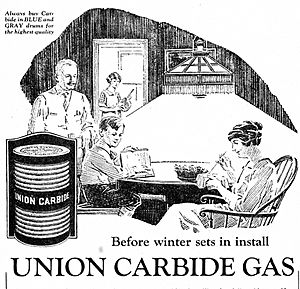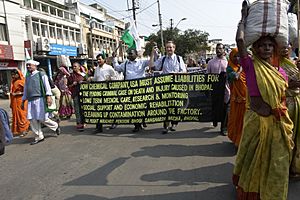Union Carbide facts for kids
 |
|
| Subsidiary | |
| Traded as | NYSE: UCC (until 2001)
DJIA component (until 1999) S&P 500 component (until 2001) |
| Industry | Chemicals |
| Founded | 1917 |
| Headquarters | Seadrift, Texas, U.S. |
|
Key people
|
Richard Wells (CEO & president) |
| Products |
|
| Revenue | |
|
Operating income
|
|
| Total assets | |
| Total equity | |
| Parent | Dow Chemical Company |
Union Carbide Corporation (UCC) is an American company that makes chemicals. Its main office is in Seadrift, Texas. Since 2001, it has been a part of the Dow Chemical Company.
Union Carbide creates chemicals and plastics that other companies use to make products. These products are then sold to people like you! They make things for paints, packaging, wires, household items, and even cars. The company was once a big part of the Dow Jones Industrial Average, which tracks major US companies.
Union Carbide started in 1917 as the Union Carbide and Carbon Corporation. It was formed when several companies joined together. Its scientists found a cheap way to make ethylene from natural gas liquids. This discovery helped create the modern petrochemical industry, which makes chemicals from oil and gas. Over the years, the company sold off many well-known brands. These included Eveready and Energizer batteries, Glad bags, and Prestone antifreeze.
Contents
The History of Union Carbide
How Union Carbide Began
The Union Carbide and Carbon Corporation was officially formed on November 1, 1917. It was a merger of several companies. These included the Union Carbide Company (started in 1898) and the National Carbon Company (started in 1886). Other companies that joined were Linde Air Products Company and Prest-O-Lite.
In 1920, Union Carbide started a chemicals division. This part of the company made ethylene glycol. This chemical is used as antifreeze in cars. The company kept growing by buying other chemical makers. One important purchase was the Bakelite Corporation in 1939. Bakelite made some of the first plastics. In 1957, the company changed its name to "Union Carbide Corporation."
Supporting Space and Defense
During the Cold War, Union Carbide helped with rocket propulsion research. This was for aerospace and guided missile uses. They worked on chemicals, plastics, and rocket fuels. Their research was done at a special center in South Charleston, West Virginia.
Changes and New Ownership
Union Carbide used to own the Ucar batteries business. This included Eveready and Energizer batteries. The company sold this battery business in 1986.
Later, in 1999, the Dow Chemical Company announced it would buy Union Carbide. The deal was completed in 2001. Since then, Union Carbide has been a fully owned part of Dow Chemical.
Hawks Nest Tunnel Disaster
A Tragic Construction Project
The Hawks Nest Tunnel disaster happened between 1927 and 1932. This was during a tunnel building project in West Virginia. Union Carbide was in charge of this project. Workers found a mineral called silica while digging. They were asked to mine it for use in making steel.
Dangers of Silica Dust
Sadly, the workers were not given masks or special breathing gear. This was despite safety practices known at the time. Because they breathed in so much silica dust, many workers got silicosis. This is a serious lung disease. A marker at the site says 109 people died. However, other reports estimate the death toll was much higher. Some say it was as many as 764 people. This makes it one of America's deadliest industrial accidents.
Asbestos Mining and 'Calidria' Fibers
Mining Asbestos for Products
In the early 1960s, Union Carbide started mining asbestos fibers. This was near King City and New Idria, California. Asbestos is a natural mineral. These fibers were sold under the brand name "Calidria." They were used in many products. For example, they were added to joint compound for drywall.
Union Carbide sold the mine to its employees in the 1980s. The mine was called KCAC. However, it only operated for a few more years after that.
The 1984 Bhopal Disaster
A Plant in India
Union Carbide India Limited (UCIL) was a company partly owned by Union Carbide (50.9%). Indian investors owned the rest. UCIL ran a pesticide plant in Bhopal, India. This plant opened in 1969. It made pesticides and herbicides. These products were made using a chemical called methyl isocyanate (MIC).
Safety Concerns and Location
The plant started making its own MIC in 1979. It was located very close to a crowded neighborhood and a busy train station. This was against the city's development plan from 1975. That plan said dangerous factories like the MIC plant should be far away from populated areas. Union Carbide India Limited's first request to build there was turned down. But they later got approval from higher authorities. In 1982, auditors warned Union Carbide about a possible dangerous chemical reaction at the plant.
The Gas Leak and Its Impact
Around midnight on December 3, 1984, gas accidentally leaked from the plant. More than 500,000 people were exposed to MIC and other chemicals. The government of Madhya Pradesh confirmed 16,000 deaths related to the gas release. It also left about 40,000 people with permanent disabilities or serious illnesses. This event is known as the world's worst industrial disaster.
Aftermath and Settlement
After the disaster, groups representing the victims asked Union Carbide for a lot of money for injuries. The Government of India also asked for money. Union Carbide offered a smaller amount. In 1989, the company paid $470 million to the Indian government as a final agreement.
After this agreement, Union Carbide sold its share in the Indian company. Union Carbide has always said the accident was caused by a plant worker. The plant site has not been cleaned up. Dangerous chemicals can still be found there today.
Warren Anderson, who was the CEO at the time, did not return to India for questioning about the disaster. He passed away on September 29, 2014, in Florida.
1985 West Virginia Gas Leak
Another Incident
The year after the Bhopal disaster, another gas leak happened. This was at a Union Carbide plant in Institute, West Virginia. A faulty valve caused a large cloud of gas. Six employees were hurt. Nearly 200 nearby residents went to the hospital. They had breathing problems and skin irritation.
Union Carbide said the leak was due to a valve failure. The leak involved aldicarb oxime, a chemical used in a farm pesticide. A company spokesperson said the leak was not a threat to the community.
Union Carbide in Australia
Operations Down Under
Union Carbide started working in Australia in 1957. They bought a factory in Rhodes, a suburb of Sydney. This factory was on the shore of Homebush Bay. The factory made chemicals like phenol and insecticides. Union Carbide continued making some of these chemicals until the 1970s and 1980s.
Cleaning Up the Site
Union Carbide also filled nearby marsh areas in Homebush Bay with waste materials. This practice stopped in 1970.
Union Carbide stopped its operations in Australia in 1985. In 1987, the New South Wales Pollution Control Commission told Union Carbide to clean up the site. This cleanup cost Union Carbide $30 million. It involved digging up and sealing off contaminated soil.
More cleanup work was approved in 2004. This included parts of Homebush Bay. A huge amount of soil and sediment was removed from the site and the bay. The cleanup of the Union Carbide site and Homebush Bay was finished in March 2011. This work cost a lot of money to make the area safe again.
Former New York Headquarters
A Tall Building in the City
The old Union Carbide headquarters building was at 270 Park Avenue in New York City. It was a 52-story office building. It was finished in 1960.
In 1983, the company moved its main office to Danbury, Connecticut. The building at 270 Park Avenue later became the headquarters for JPMorgan Chase. This building was later taken down. A new, much taller building is being built in its place. The Union Carbide Building was the tallest building in the world ever taken down on purpose at that time.
See also
 In Spanish: Union Carbide para niños
In Spanish: Union Carbide para niños
- BASF
- National Carbon Company
- Carbide & Carbon Building
- Union Carbide Corporate Center



